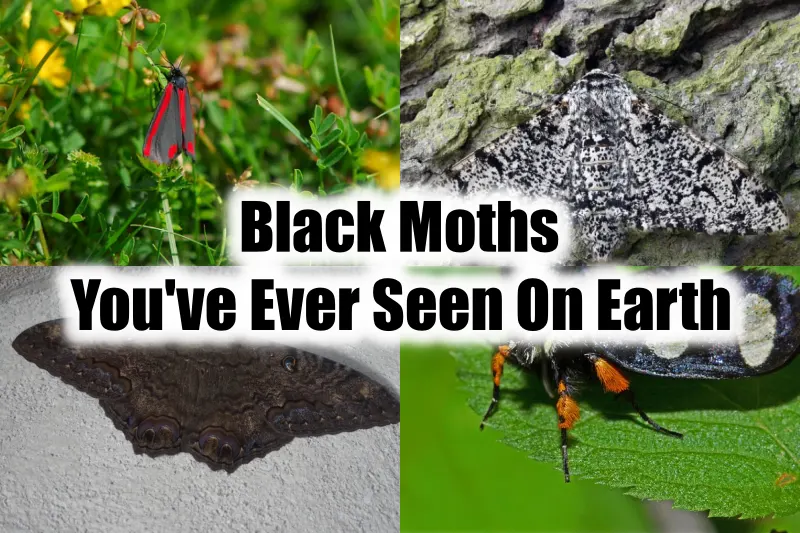Everyone of us always wonders about how beautiful the creatures are, especially butterflies and moths. There are plenty of colors in nature. But have you ever thought about how a moth looks if it has a black color? The black color is as deep as you can see, and these little flying members of the animal kingdom These black moths are beautiful and gorgeous, like butterflies. Some of them got confused with butterflies.
Today we are going to look at 25 types of black moths. Here is the list:
25 Black Moths You’ve Ever Seen On Earth
1. Black Witch Moth
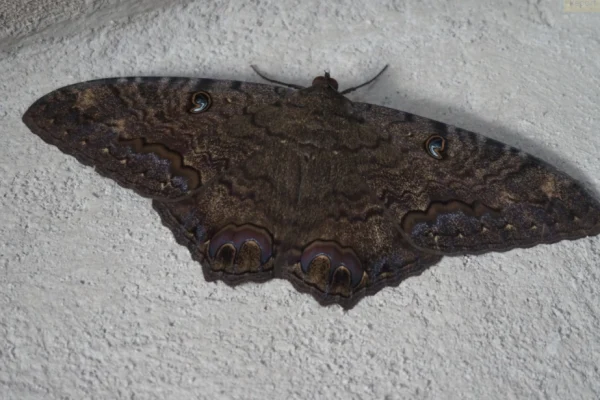
| Scientific name | Ascalapha odorata |
| Identification | small spot on each forewing |
| Geographical location | United States, Brazil |
Ascalapha odorata is a large, bat-shaped, dark-colored nocturnal moth found from the southern United States to Brazil. Also known as the black witch.
Female moths have a wingspan of 24 cm and a diagnostic marking of a small spot on each forewing, often green with orange highlights.
Males are smaller, darker, and lack the white bar crossing the wings. The larva is a large caterpillar with intricate black and greenish-brown spots and stripes.
2. Ocean Spray Fairy Moth

| Scientific Name | Adela septentrionella |
| Identification | two thin white bands |
| Geographical location | Southern British Columbia, southern California, and north-western Idaho |
Adela septentrionella is a moth found in southern British Columbia, north-western Idaho, and southern California. Its forewing is black with purplish-brown iridescence and two thin white bands.
The head is black in males with a bushy tuft of erect black scales, while females have orange head scaling.
The moth has intermediate-sized eyes, with antennae longer than in some large-eyed species. The hindwing is uniformly dark with a wide fringe. The species is widespread from southern British Columbia to the Transverse Range.
3. Eight-spotted Forester Moth

| Scientific Name | Alypia octomaculata |
| Identification | Eight white spots |
| Geographical location | Canada |
The eight-spotted forester moth is a species of moth native to Canada. This black moth is known for its large white patches on its black wings. It has bright orange-red leg hairs. In total, this moth has eight spots, two on each wing.
This moth is often mistaken for a butterfly due to its daytime flight and frequent sightings of flowers. Found in forests and woodlands, particularly near host plants that feed larvae.
The moth’s wingspan is around 30-37 mm, and its forewing ranges between shades of white, cream, or yellow. The moth is active during the day and night, often being mistaken for a butterfly.
4. Black Zale Moth
| Scientific Name | Zale undularis |
| Identification | Brown wing with a black border |
| Geographical location | eastern United States and southern Ontario |
The black zale moth is a moth found in the eastern United States and southern Ontario. Its antennae are brown and thread-like, while its head, body, abdomen, and wings are dark brown, bordering on black.
The wings are slightly dentated, with a series of black indented lines or bars on the anterior ones. The posterior wings are marked exactly like the superior ones.
The underside is lighter and fainter, with similar markings but fainter. The wingspan is about 2 inches and are blackish-brown to coal black with inconspicuous wavy black lines.
5. Grapeleaf Skeletonizer Moth

| Scientific Name | Harrisina americana |
| Identification | feather-like antennae |
| Geographical location | United States |
The grapeleaf skeletonizer is a moth in the Zygaenidae family found in the eastern half of the United States. It is known for defoliating grapes, particularly the Virginia creeper.
Adults have narrow black wings and a reddish collar, with wingspans of 18–28 mm and lengths of 8–12 mm. Larvae have a dark head and yellow body with a black band across each abdominal segment.
Adults are uniformly black, with a reddish or orange collar, a long and narrow body, and a curled abdomen. They are active during the day and night and live only a few days.
6. Chimney Sweeper Moth
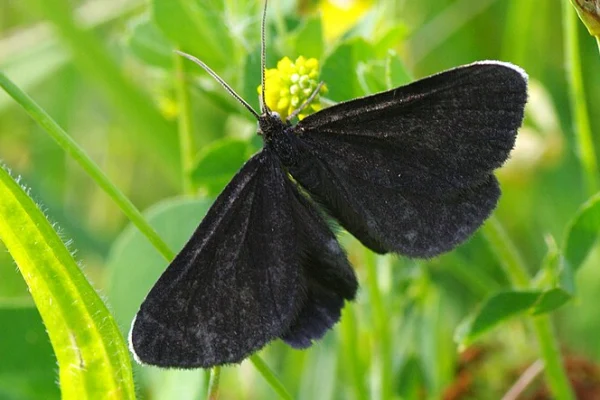
| Scientific Name | Odezia atrata |
| Identification | Black wing with white apical fringe |
| Geographical location | England, Wales, Scotland, and Ireland |
The chimney sweeper is known for its sooty-black body and wings, with a white fringe around the tips of the forewings. The wingspan is 23–27 mm, and the forewings are 12–15 mm long.
The wings are almost entirely black, with the extreme apex and apical fringe being white. The chimney sweeper is mistaken for a small blue butterfly. In some species, the wings and forewings are dusted with brownish yellow.
7. Buck Moth
| Scientific Name | Hemileuca maia |
| Identification | greyish-black abdomen |
| Geographical location | Eastern United States |
Buck moths have a wingspan of 2-3 inches and a grayish-black abdomen with a reddish orange or dark coloration at the tip. They have a stout, hairy body with a grayish-black abdomen and a reddish-orange or dark coloration at the tip.
Full-grown caterpillars are about 2 inches long and can vary in color. The head and legs range from orange to dark red or black, while the rest is black with small white spots.
The body is covered with tufts of short spines at the base of longer, branched spines, sometimes with lighter colors. Young caterpillars may be darker than mature ones.
8. Virginia Ctenucha Moth
| Scientific Name | Ctenucha virginica |
| Identification | metallic blue abdomen |
| Geographical location | northeastern North America, Labrador, Pennsylvania, Manitoba, and Kansas |
The Virginia Ctenucha moth is a large northern wasp moth. These black moths have a metallic blue body and a black, translucent hindwing. The moth’s wings are long and have a hint of bright white along the fringe.
The orange head is covered in hair. The thorax is also shiny, metallic blue. The moth feeds on grasses, sedges, and irises, producing two broods each year.
9. Garden Tiger Moth
| Scientific Name | Arctia caja |
| Identification | Black dots on the wing |
| Geographical location | United States, Canada, and Europe |
The garden tiger moth is a northern species of the Erebidae family. Found in the US, Canada, and Europe. Also known as the great tiger moth. It prefers cold climates with temperate seasonality and hosts that produce pyrrolizidine alkaloids.
The moth has a wingspan of 45 to 65 millimeters. It varies in design, with the front wings brown with a white pattern and the back wings orange with black dots. There are about 500 different variants.
10. White-tipped black moth
| Scientific Name | Melanchroia chephise |
| Identification | white margined tips |
| Geographical location | Florida, Texas, and Paraguay |
Melanchroia chephise is a white-tipped black or snowbush spanworm moth found in Florida, Texas, and Paraguay. It has a 33-mm wingspan. It is a day-flying moth, unlike most moths, which are covert night-time navigators.
The moth has navy-blue, black wings with white margined tips and an orange thorax. Founded in Arizona, Oklahoma, Arkansas, Kansas, and Illinois.
11. Cinnabar Moth
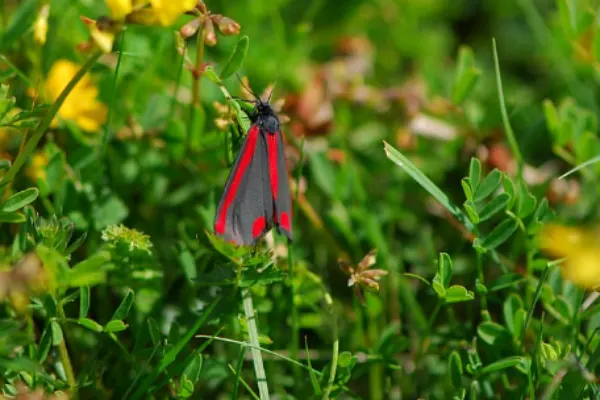
| Scientific Name | Tyria jacobaeae |
| Identification | black wings with red patches |
| Geographical location | Europe, western and central Asia, and China |
The cinnabar moth is a brightly colored arctiid moth. It is native to Europe, western and central Asia, and China. Also seen in New Zealand, Australia, and North America to control ragwort.
Named after the red mineral cinnabar, it has predominantly black wings with red patches. The species, which measures 20mm in length and 32–42 mm in wingspan, is day-flying with distinctive pinkish-red and black wings. They can be seen with yellow markings or with black wings.
12. Red-necked Footman
| Scientific Name | Atolmis rubricollis |
| Identification | orange thorax |
| Geographical location | Europe and northern Asia |
Atolmis rubricollis also known as the red-necked footman. Found in forested regions of Europe and northern Asia. It is mostly dark brown, with a conspicuous orange thorax behind the black head.
The hindwings are brownish gray, and the antennae and legs are black. The wings are tightly folded and have pleated ends.
13. Mournful Thyris Moth
| Scientific Name | Pseudothyris sepulchralis |
| Identification | black body with white spots |
| Geographical location | North America |
Pseudothyris sepulchralis is a day-flying moth found in North America. Also known as the mournful thyris. It has a flight duration of 2–3 weeks and is rarely found on flowering plants for feeding.
Adults have a wingspan of 15–23 millimeters and a black body with white spots and marks. Larvae feed on Smilax species. Adults are active from spring to summer, feeding grapevines and clematis vines.
14. Waved black
| Scientific Name | Parascotia fuliginaria |
| Identification | blackish-fuscous forewing |
| Geographical location | Europe, North America, Armenia, and Asia |
Parascotia fuliginaria is a moth species found in Europe, Armenia, and Asia. It is an introduced species in North America. The moth has a blackish fuscous forewing, yellowish ochreous lines, and a black mark at the end of the cell.
The male has pale ochre wings and terminal spots, while the female is pale yellowish brown. The larva is black, with a white dorsal stripe, a black line in the middle, and wavy lateral lines. The wingspan is 18–28 mm, and the forewings are 11–14 mm long.
15. Yellow-collared Scape Moth
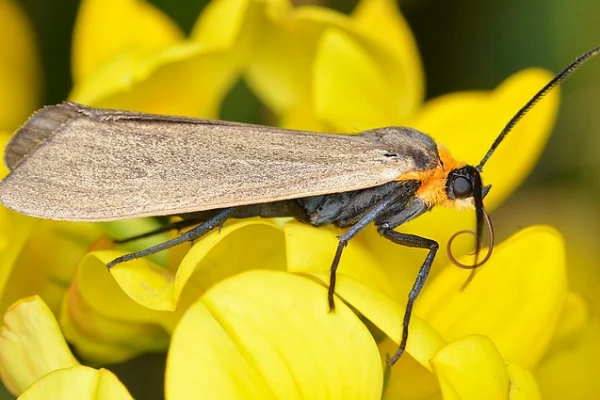
| Scientific Name | Cisseps Fulvicollis |
| Identification | orange collar with a black thorax |
| Geographical location | North America, southeastern US |
The Yellow-collared Scape Moth is a moth that eats nectar from various flowers, including goldenrod, asters, milkweed, and blazing star. Its wings are opaque and may reflect blue in sunlight.
Adults are active from late spring to late autumn, eating grass, sedge, rushes, and lichens. They have a dark brown or black body, an orange collar, a black thorax, a black abdomen, and pectinate antennae.
16. Joyful Virbia Moth
| Scientific Name | Virbia laeta |
| Identification | red and black hind wing |
| Geographical location | North America, southern and southeastern US |
Virbia laeta is also known as the joyful holomelina. These black moths are in the Erebidae family. Its habitat is pine woodlands.
The species has a black appearance with red sections and black forewings and hindwings. The late-instar Joyful Virbia Moth Caterpillar also has a black appearance. Its wingspan can reach 0.6 inches. Found in North America, southern and southeastern US.
17. Peppered moth

| Scientific Name | Biston betularia |
| Identification | Wings are white, “peppered” with black |
| Geographical location | England, Europe, and North America |
The peppered moth is a temperate night-flying moth found in the northern hemisphere, primarily in Asia, Europe, and North America. Its evolution is a result of population genetics and natural selection.
The moth has a wingspan ranging from 45 mm to 62 mm and stout-body with narrow-elongate forewings. Its wings are white, “peppered” with black, and have distinct cross lines. The black speckling varies in amount, and males have strongly bipectinate antennae.
18. White-striped black moth
| Scientific Name | Trichodezia albovittata |
| Identification | antennae as long as its body |
| Geographical location | Eastern North America |
The white-striped black moth is a moth found in eastern North America. Its wingspan is 20–25 mm. It has a black body with fewer white marks compared to similar moths.
The male Black Shawl Moth has antennae as long as its body, and its wingspan is variable, with most having a wingspan between 1 and 2 inches. The larvae feed on Impatiens species. Found in coastal regions and woodlands.
19. Jersey Tiger Moth
| Scientific Name | Euplagia quadripunctaria |
| Identification | cream-colored with bold black stripes forewings |
| Geographical location | Europe, Estonia, Russia, the southern Urals, Asia, Rhodes, and Iran |
The Jersey Tiger is a diurnal moth with a wide wingspan of 52–65 millimeters. Also known as the Spanish Flag. Its forewings are cream-colored with bold black stripes. And its underwings are bright orange with black patches.
The caterpillars are black with a wide yellow stripe along the back and cream spots along the sides. They fly during the day and at night, and their head is black.
20. Pompelon
I just met this snippet of electrified velvet. Extraordinary creature! This is Pompelon Marginata – a species of day-flying moth. Drink in that beauty!! pic.twitter.com/keCYRjQDZW
— incidental naturalist (@IncNaturalist) May 12, 2022
| Scientific Name | Pompelon marginata |
| Identification | iridescent blue margins |
| Geographical location | Philippines, Thailand, Myanmar, Peninsular Malaysia, Sulawesi, Borneo, Singapore, and Sumatra |
P. marginata is a mid-sized day-flying moth with predominantly black and rounded wings and iridescent blue margins. Its has red band at his head. Its dark dorsal side features a bright red thorax and abdomen.
The butterfly has black legs with a blue metallic sheen. The heart-shaped butterfly has two blue antennas sticking out the top, and its wings spread out into a heart shape.
The butterfly is dark blue or black in the center and toward the top, then fades into a lighter, common shade of blue.
21. Six-spot burnet

| Scientific Name | Zygaena filipendulae |
| Identification | six red spots on each wing |
| Geographical location | England, the coasts of Wales, and Scotland |
Six-spot Burnet Moths are day-flying moths with brightly colored wings, iridescent dark green wings, and six red spots on each. The moth’s yellow and black caterpillars pupate on grass stems, forming a yellow chrysalis.
There is a rarer form with yellow spots. Found in England and the coasts of Wales and Scotland. These black moths fly with a wing span of approximately 35mm.
Its blackish-blue front wings have a metallic shine. These black moths have six red round spots. Its hind wings are crimson with a narrow dark blue or black border.
22. White-spotted sable
| Scientific name | Anania funebris |
| Identification | large white subdorsal spot |
| Geographical location | Europe, Siberia, and North America |
Anania funebris, the white-spotted sable moth, is a diurnal dayflying moth found in Europe, Siberia, the northern parts of the Far East, and North America.
Its wingspan is 20–23 mm, and it has black forewings, a large white subdorsal spot, and white cilia towards the tips.
The larva has an ochreous-whitish, deep green, spiracular whitish-green, dots of green, and a whitish-brown head.
23. Argent and sable moth
| Scientific name | Rheumaptera hastata |
| Identification | black and white pattern |
| Geographical location | Europe, Russia, China, and Japan |
The argent and sable moth is a day-flying moth in the Geometridae family. These black moths have black and white prints. They typically live on wetlands and hillsides.
The wings have a black ground color with variable white pattern elements, a wide inner cross, and a narrow basal cross line.
The dark has white patches, while the outer cross-line forms a wide white band with black dots. The margin has a wavy line broken into white stains, forming an arrow- or spearhead-shaped element. The fringes are black and white patchwork.
24. Black and yellow lichen moth

| Scientific name | Lycomorpha pholus |
| Identification | bluish-black wings with yellow, orange, or red basal and black distal areas |
| Geographical location | North America |
Lycomorpha pholus is a black-and-yellow lichen moth found primarily in short-grass prairies.
Found in North America, adults have bluish-black wings with yellow, orange, or red basal and black distal areas and fly during the day.
Adults have a bluish sheen and are black with a bluish sheen.
25. Uncle Sam Moth
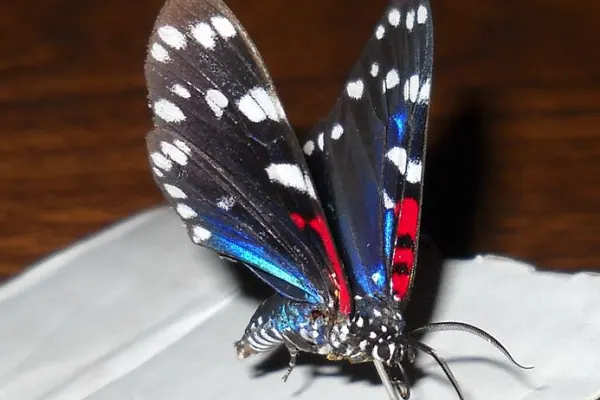
| Scientific name | Composia fidelissima |
| Identification | blue color at the center and abdomen |
| Geographical location | Southern Florida, and Cuba |
The Composia fidelissima, also known as the faithful beauty or Uncle Sam moth, is a moth found in southern Florida and the West Indies, including Cuba.
These black moths fly with a 48–64 mm wingspan. This beautiful moth has black wings with white spots at the lower edge and three red spots at each wing’s upper side edge.
The most attractive feature of this moth is the beautiful blue color at the center and abdomen. This blue color glows in the light. And this feature makes this moth more adorable.
- Conclusion:
As we look at how beautiful and gorgeous these black moths are and admire their adorable black beauty. You might see these beautiful creatures around you. This is it for today; we will be back with some more facts. Till then, keep looking for it with How It See.
FAQs:
Q1. Where does one find the Black Witch Moth?
Ans: The Black Witch Moth is found from the southern United States to Brazil.
Q2. What distinguishes the identification of the Ocean Spray Fairy Moth?
Ans: The Ocean Spray Fairy Moth has black forewing with purplish-brown iridescence and two thin white bands.
Q3. What are the characteristics of the Eight-spotted Forester Moth?
Ans: The Eight-spotted Forester Moth has large white patches on its black wings, featuring eight white spots, two on each wing.
Q4. Where is the Black Zale Moth found?
Ans: The Black Zale Moth is found in the eastern United States and southern Ontario.
Q5. Describe the appearance of the Grapeleaf Skeletonizer Moth.
Ans: The Grapeleaf Skeletonizer Moth has narrow black wings and a reddish collar, with feather-like antennae.
Q6. What makes the Chimney Sweeper Moth unique in appearance?
Ans: The Chimney Sweeper Moth has sooty-black body and wings with a white apical fringe.
Q7. Where is the common habitat of the Buck Moth?
Ans: Buck Moths is found in the Eastern United States.
Q8. What distinguishes the Virginia Ctenucha Moth’s wings?
Ans: The Virginia Ctenucha Moth has a metallic blue abdomen and black, translucent hindwings.
Q9. What are the identifying features of the Garden Tiger Moth?
Ans: The Garden Tiger Moth has brown front wings with a white pattern and orange hindwings with black dots.
Q10. Where is the White-tipped Black Moth predominantly located?
Ans: The White-tipped Black Moth is found in Florida, Texas, and Paraguay.
Also Read:

As a content writer, I like to write about different niches. I have a curiosity about nature and animals. And like to learn about them. Through my writing, I like to share my experience and knowledge with you. I hope you are enjoying it too.
